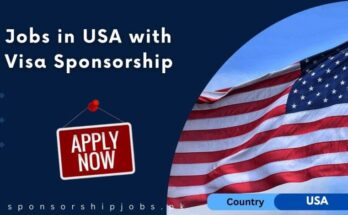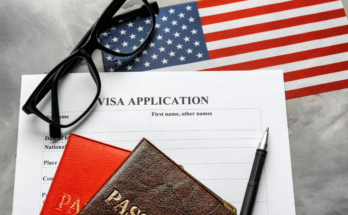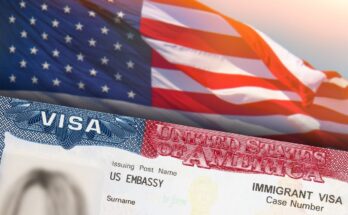The United States has long been a top destination for international students seeking higher education. With its globally recognized universities, diverse programs, and ample opportunities, the USA remains a dream location for millions of students worldwide. However, understanding the process of obtaining a study visa and the concept of visa sponsorship is crucial for success.
In this article, we’ll walk you through the different types of study visas, the application process, sponsorship requirements, and everything else you need to know to get started.
Types of USA Study Visas
There are three primary types of study visas available to international students:
F-1 Visa (Academic Students)
The F-1 visa is the most common type for international students pursuing academic programs, including bachelor’s, master’s, and doctoral degrees. Students under this visa can also participate in Optional Practical Training (OPT), allowing temporary work related to their field of study.
M-1 Visa (Vocational Students)
For those interested in non-academic programs, such as technical or vocational training, the M-1 visa is the appropriate choice. Unlike the F-1 visa, M-1 students have more limited work opportunities during and after their program.
J-1 Visa (Exchange Visitors)
The J-1 visa is primarily for exchange programs, including student exchanges, research, and training programs. Many J-1 visa holders are sponsored by government or private exchange programs.
Eligibility Criteria for a USA Study Visa
To qualify for a study visa, you must meet specific requirements set by the U.S. government.
Enrollment in a SEVP-Approved School
You must be accepted by a school that is part of the Student and Exchange Visitor Program (SEVP). These schools issue the Form I-20, which is required for your visa application.
Proof of Financial Capability
The U.S. government requires proof that you can afford tuition, living expenses, and other costs without needing to work illegally. Bank statements, sponsorship letters, or other financial documents are commonly used for this purpose.
English Proficiency Requirements
Most U.S. institutions require international students to demonstrate proficiency in English through tests like the TOEFL, IELTS, or PTE.
Valid Passport and Supporting Documents
A passport valid for at least six months beyond your intended stay is essential. Additional documents, such as academic transcripts and letters of acceptance, are also required.
Steps to Apply for a USA Study Visa
The application process for a USA study visa involves several crucial steps:
Step 1 – Apply to a SEVP-Approved Institution
Research and apply to universities or colleges that match your academic goals. Once accepted, the school will provide you with a Form I-20 (for F-1 and M-1 visas).
Step 2 – Receive Form I-20
This document is essential for your visa application and confirms your acceptance into a program. Keep it safe as you’ll need it throughout your time in the U.S.
Step 3 – Pay the SEVIS Fee
The SEVIS fee is used to maintain the Student and Exchange Visitor Information System. You must pay this fee before applying for your visa.
Step 4 – Complete the DS-160 Form
The DS-160 form is an online non-immigrant visa application form. Completing this form accurately is critical for a smooth application process.
Step 5 – Schedule a Visa Interview
After submitting the DS-160, schedule an interview appointment at the nearest U.S. embassy or consulate.
Step 6 – Prepare for and Attend the Interview
Gather all required documents, including your I-20 form, financial proof, and passport. During the interview, be honest, confident, and clear about your intentions to study in the USA.
Visa Sponsorship for International Students
Many students wonder about the concept of visa sponsorship and who can act as a sponsor during the visa application process.
What Is Visa Sponsorship?
Visa sponsorship refers to financial or legal support provided to help a visa applicant meet the U.S. government’s requirements. For students, sponsorship typically involves covering tuition, living expenses, or both.
Who Can Sponsor a USA Study Visa?
Sponsors can include parents, relatives, employers, or educational institutions. Some scholarships also act as sponsorships by covering a portion of your costs.
Financial Sponsorship Requirements
Sponsors must provide documentation proving they can financially support you throughout your studies. This may include bank statements, tax returns, and an affidavit of support.
USA Study Visa Interview Tips
The visa interview is a critical step in the application process. It’s often the deciding factor on whether your visa gets approved. Preparation is key to making a strong impression.
Common Questions Asked During the Interview
During the interview, expect questions about your educational background, future plans, and financial situation. Common questions include:
- Why do you want to study in the USA?
- What is your intended major?
- Who is sponsoring your education?
- Do you plan to return to your home country after your studies?
Make sure to give concise, honest answers that demonstrate your commitment to studying and returning home upon completion of your degree.
Documents You Need to Bring
Here’s a checklist of documents you must take to your visa interview:
- Passport (valid for at least six months beyond your stay)
- Form I-20 or DS-2019 (for J-1 visa applicants)
- DS-160 confirmation page
- SEVIS fee receipt
- Academic records (transcripts, diplomas)
- Proof of financial support (bank statements, sponsorship letter)
Having all necessary documents organized in advance will save you time and reduce stress.
How to Make a Good Impression
Dress professionally to show you’re serious about your studies. Be polite, maintain eye contact, and answer questions clearly. Avoid memorizing responses word-for-word; instead, understand the key points you want to convey. Confidence and preparation will go a long way in gaining the trust of the consular officer.
Costs and Fees Associated with USA Study Visas
Obtaining a USA study visa involves several fees. It’s essential to budget for these costs early to avoid any last-minute financial surprises.
SEVIS Fee
The SEVIS fee (Student and Exchange Visitor Information System) is a mandatory payment for international students. For F-1 and M-1 students, the fee is $350, while J-1 applicants typically pay $220. This fee supports the electronic system that tracks students throughout their stay in the USA.
Visa Application Fee (DS-160)
You’ll need to pay a non-refundable visa application fee, usually $185. This fee covers the cost of processing your visa and conducting your interview.
Additional Costs (Health Insurance, Travel, etc.)
Other expenses include:
- Health insurance (often required by universities)
- Travel expenses (airfare, transportation within the USA)
- Living costs, including housing, meals, and textbooks
Proper financial planning can prevent you from facing unnecessary stress later on.
Work and Study Options in the USA
While studying in the USA, you may have limited work opportunities, depending on your visa type and academic program.
On-Campus Employment for F-1 Students
F-1 visa holders can work up to 20 hours per week on campus during the academic year and full-time during breaks. Jobs may include positions at the campus library, dining services, or research labs. This work option provides students with a chance to earn extra money and gain experience.
Optional Practical Training (OPT)
OPT allows F-1 students to work in their field of study for up to 12 months after completing their program. STEM (Science, Technology, Engineering, and Mathematics) students may be eligible for a 24-month extension, providing a total of 36 months of work experience.
Curricular Practical Training (CPT)
CPT is designed for students to gain practical experience related to their studies through internships or cooperative programs. Unlike OPT, CPT is done during the course of study and requires approval from your school’s Designated School Official (DSO).
Challenges Faced by Immigrant Students
Moving to a new country can be both exciting and overwhelming. Many international students face challenges during their transition to life in the USA.
Cultural Adjustment
Adapting to American culture can take time. Differences in language, customs, and social norms may feel unfamiliar at first. Engaging with local communities, joining campus activities, and staying in touch with friends and family can ease the adjustment period.
Academic Pressure
The academic environment in the USA may be different from what you’re used to. Courses often require critical thinking, participation in discussions, and time management skills. If you’re struggling, don’t hesitate to seek support from academic advisors or tutors.
Financial Struggles
Living and studying in the USA is expensive. Between tuition, housing, and daily expenses, it’s easy to feel overwhelmed. To manage your finances, create a budget, explore scholarship opportunities, and take advantage of on-campus employment if eligible.
Benefits of Studying in the USA
Despite the challenges, studying in the USA offers numerous advantages that can positively shape your academic and professional future.
High-Quality Education
The USA is home to many of the world’s top universities. Institutions like Harvard, MIT, Stanford, and others offer cutting-edge research opportunities, experienced faculty, and state-of-the-art facilities.
Diverse Learning Environment
American universities attract students from around the world, fostering a multicultural environment. This diversity helps students develop global perspectives and build a network of international contacts.
Career Advancement Opportunities
A degree from a U.S. university can significantly boost your career prospects. Many multinational companies value the skills and experience gained through an American education, giving you a competitive edge in the job market.
Maintaining Your USA Study Visa Status
It’s crucial to stay compliant with your visa conditions to avoid jeopardizing your status as an international student.
Full-Time Enrollment Requirements
You must remain enrolled full-time each semester to maintain your visa. Dropping below full-time status without prior approval from your DSO can result in serious consequences.
Visa Renewal and Extensions
If your program takes longer than expected, you may need to renew your visa or apply for an extension. Begin this process early to avoid any lapses in your legal status.
Traveling Outside the USA with a Study Visa
If you plan to travel outside the USA, ensure that your visa and I-20 form are valid for re-entry. You’ll need the DSO’s signature on your I-20 to return to the USA without issues.
Common Reasons for Visa Rejection
Unfortunately, not all visa applications are approved. Understanding common reasons for rejection can help you avoid mistakes.
Insufficient Documentation
Failing to provide all required documents is one of the most common reasons for denial. Double-check your checklist and ensure that everything is in order before your interview.
Lack of Financial Proof
Consular officers need to be assured that you can afford your education and living expenses. If your financial documentation is unclear or inadequate, your visa may be rejected.
Inadequate Answers in the Interview
If you fail to convincingly explain your study plans or intentions to return home, your application could be denied. Be prepared to articulate your goals and reasons for choosing the USA.
Pathways to Permanent Residency for International Students
For those who wish to stay in the USA after completing their studies, there are several pathways to permanent residency (green card).
Transition from Student Visa to Work Visa
Many graduates transition from an F-1 visa to an H-1B work visa, which allows them to work in specialized fields. Employers often sponsor this visa, which can eventually lead to a green card.
Employment-Based Green Card Options
Certain employment-based green cards, such as the EB-2 or EB-3, are available to skilled workers and professionals. These require employer sponsorship and meet specific job market criteria.
Marriage or Family Sponsorship
If you marry a U.S. citizen or have close relatives who are permanent residents, you may be eligible for family-based sponsorship. This is one of the fastest ways to obtain a green card.
How to Seek Legal Assistance
Navigating the complexities of U.S. immigration laws can be overwhelming. Seeking legal assistance can provide peace of mind.
Immigration Lawyers and Their Role
Immigration lawyers specialize in helping clients with visa applications, extensions, and appeals. They can offer tailored advice to ensure you meet all requirements.
Free and Low-Cost Legal Services
If you can’t afford a lawyer, look for non-profit organizations that provide free or low-cost immigration services. Universities often have legal advisors to assist international students.
Conclusion
Securing a USA study visa and sponsorship may seem challenging, but with the right preparation, it’s entirely achievable. The process involves research, documentation, and persistence. Stay organized, seek help when needed, and remain focused on your goals.
Good luck with your journey to studying in the USA!



